《中考新突破》2016年中考英语(云南版)精讲课件:专题十一 情态动词 (共21张PPT)
文档属性
| 名称 | 《中考新突破》2016年中考英语(云南版)精讲课件:专题十一 情态动词 (共21张PPT) |  | |
| 格式 | zip | ||
| 文件大小 | 576.4KB | ||
| 资源类型 | 教案 | ||
| 版本资源 | 通用版 | ||
| 科目 | 英语 | ||
| 更新时间 | 2016-05-10 21:25:31 | ||
图片预览


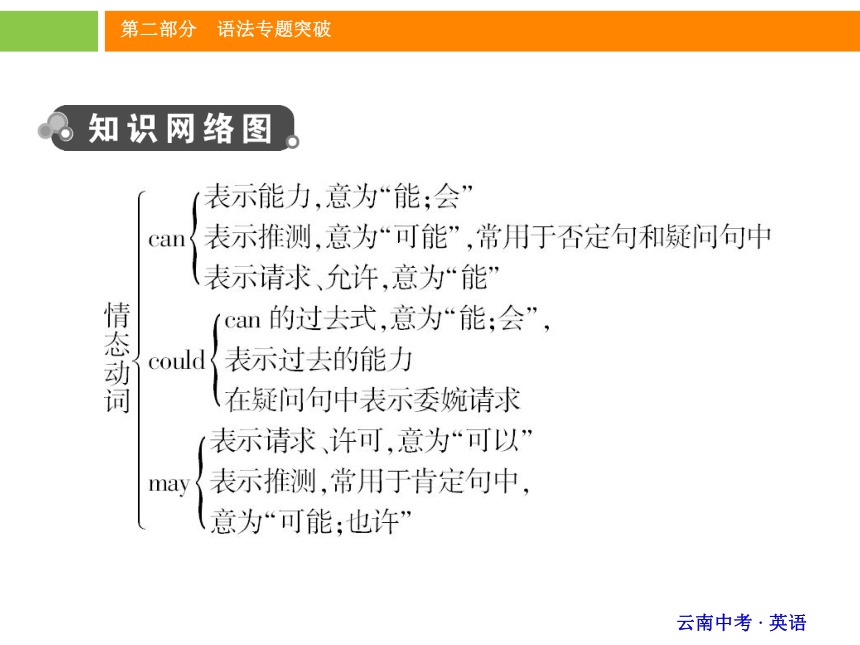
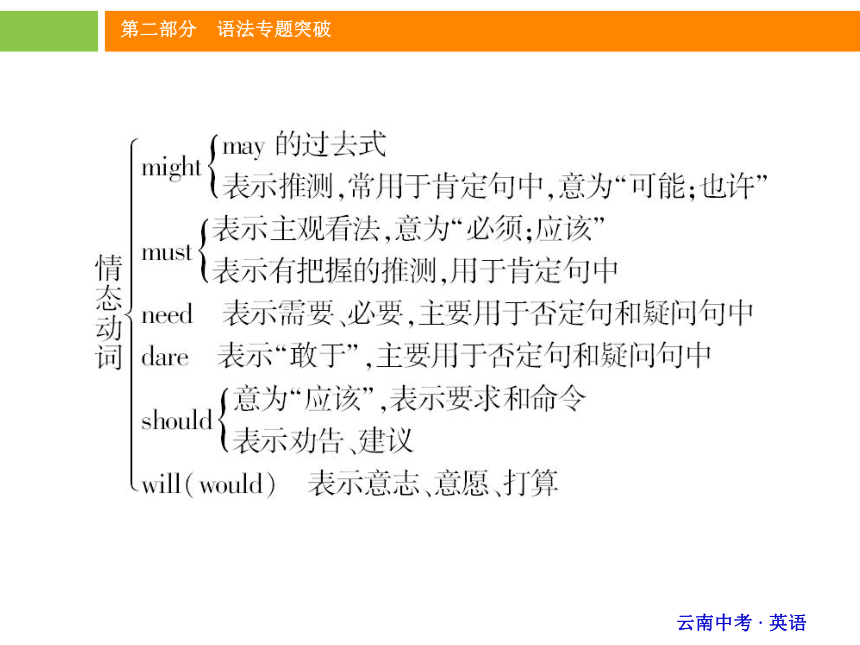
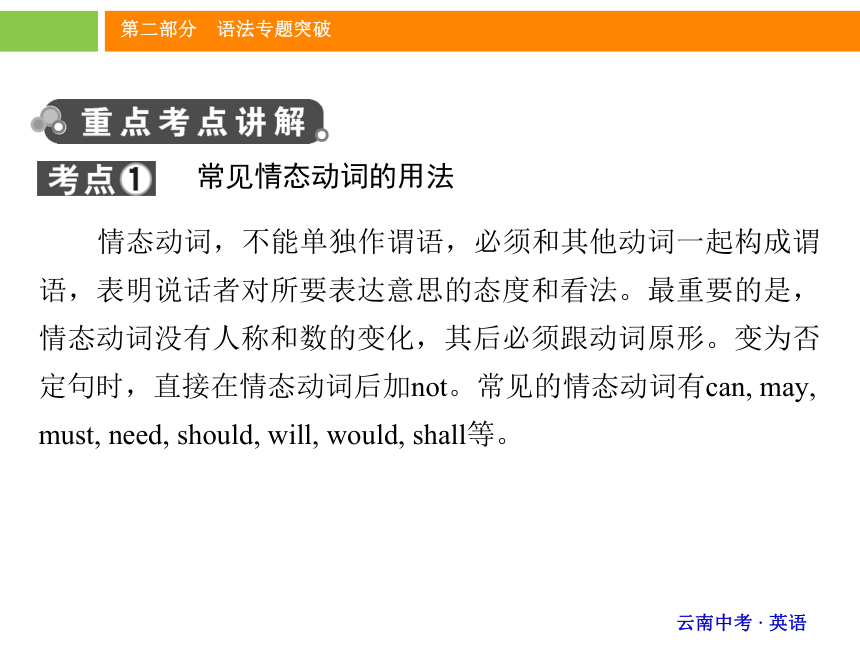
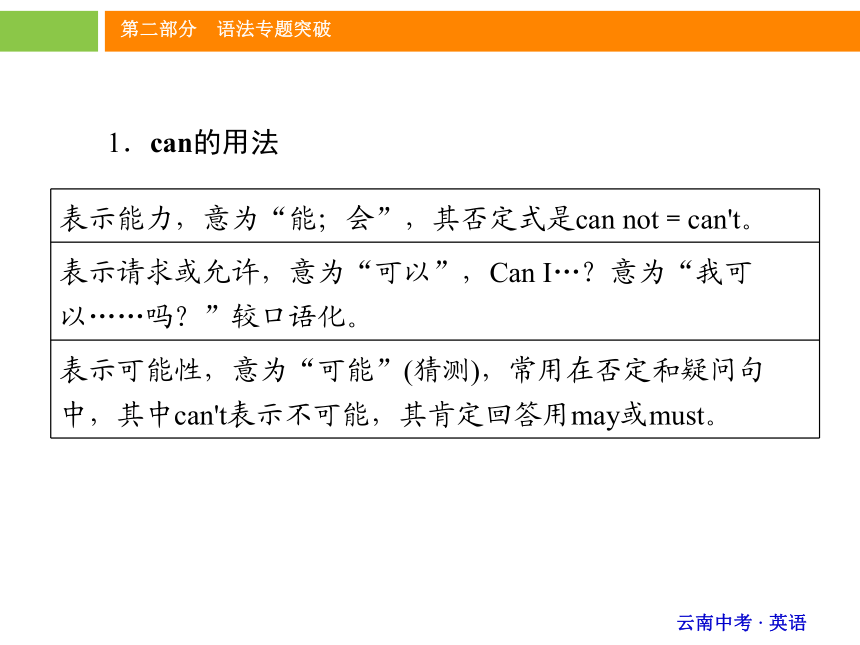
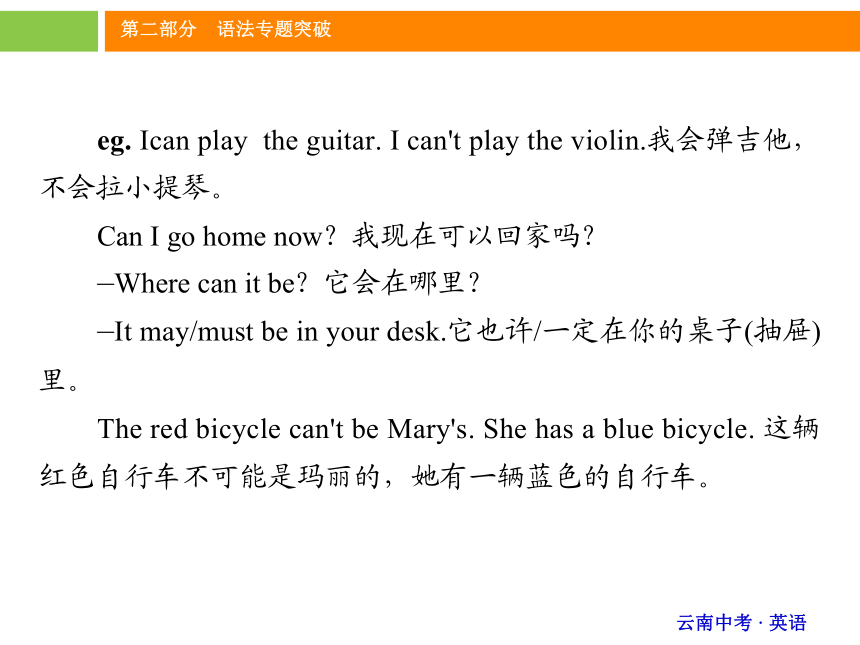

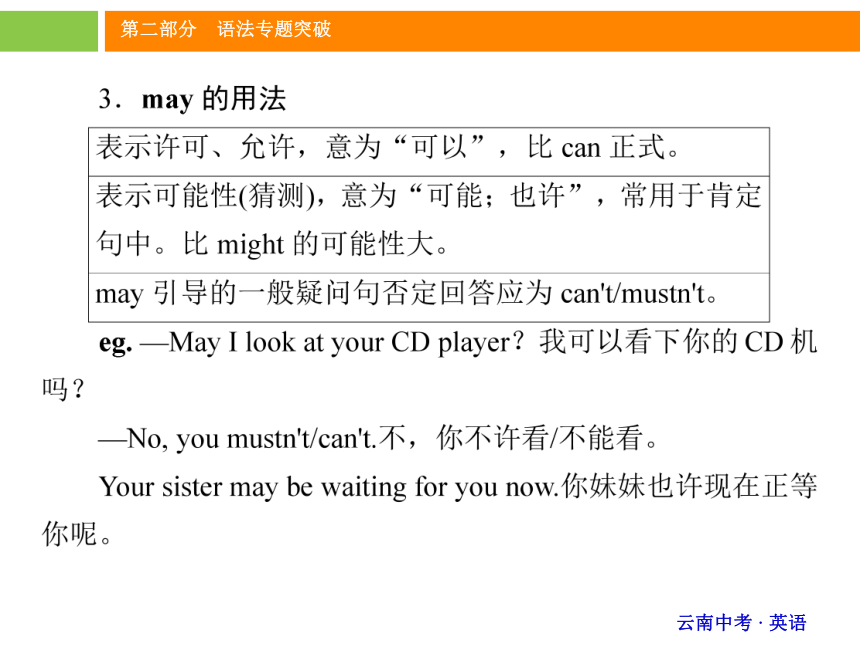
文档简介
课件21张PPT。专题十一 情态动词情态动词,不能单独作谓语,必须和其他动词一起构成谓语,表明说话者对所要表达意思的态度和看法。最重要的是,情态动词没有人称和数的变化,其后必须跟动词原形。变为否定句时,直接在情态动词后加not。常见的情态动词有can, may, must, need, should, will, would, shall等。 常见情态动词的用法 1.can的用法
eg. Ican play the guitar. I can't play the violin.我会弹吉他,不会拉小提琴。
Can I go home now?我现在可以回家吗?
—Where can it be?它会在哪里?
—It may/must be in your desk.它也许/一定在你的桌子(抽屉)里。
The red bicycle can't be Mary's. She has a blue bicycle. 这辆红色自行车不可能是玛丽的,她有一辆蓝色的自行车。
4.might的用法
may的过去式,表示猜测,可能性比could小。eg.
—Whose guitar is this? 这是谁的吉他?
—It might belong to Alice. She plays the guitar.也许是爱丽丝的。她弹吉他。
eg. We must work hard at English. 我们必须努力学习英语。
You mustn't go swimming today.你今天不许去游泳。
The man must be our new P.E. teacher. 那个男人一定是我们新来的体育老师。
—Must I finish my work now?现在我必须完成工作吗?
—No, you needn't/don't have to. 不,你不必要。
6.have to的用法
must与have to的区别:must表示说话人的主观看法;have to表示客观原因。eg.
He had to stay at home because of the heavy rain. 因为雨很大,他不得不呆在家。
7.need的用法
eg. He needn't come here. 他不需要来这儿。
We need to tell him the truth.我们需要告诉他真相。
The flowers need watering. 这些花需要浇水。
Do you need any help?你需要帮忙吗?
—Need I go there tomorrow?明天我需要去那儿吗?
—Yes, you must. /No, you needn't.是的,你必须去。/不,你不必去。
8.shall的用法
shall用于第一人称表示征求意见或询问。eg.
What shall we do tomorrow? 我们明天干什么?
9.should的用法
should意为“应该”,表示一种责任或义务,也可表示劝告或建议。是shall的过去式,与oughtto同义。eg.
You should wait a little more. 你应该再多等一会儿。
10.will的用法
will用于第二人称表示征求意见或请求,也可以用于各种人称,表示意愿。eg.
Will you pass me the dictionary? 请把那本字典递给我好吗?
I will do anything for him. 我愿意为他做任何事。
11.would的用法
would用来表示过去的意愿或委婉地询问。eg.
Isaid I would do anything for him.我说过我愿意为他做任何事。
Would you mind opening the window? 打开窗户你介意吗?
12.hadbetter的用法
had better意为“最好”,没有人称和数的变化,后接不带to的不定式,即动词原形。eg.
You'd better go there by bus.你最好乘公共汽车去那儿。
情态动词用法口诀
情态动词两要点:动词原形跟后面,
说话语气较委婉;can表“能力”may“许可”;
must“责任”或“义务”,否定回答“needn't”换;
should“应该”,would“愿”,have to“被迫”表客观。 含有情态动词的被动语态的结构为“情态动词+be+done(动词的过去分词)”。eg.
More and more trees must be planted in China.在中国必须种植更多的树木。
Many of the stars can not be seen because they are far away from us.很多星星我们都看不到,因为它们离我们太远了。 情态动词的被动语态谢谢观看!
eg. Ican play the guitar. I can't play the violin.我会弹吉他,不会拉小提琴。
Can I go home now?我现在可以回家吗?
—Where can it be?它会在哪里?
—It may/must be in your desk.它也许/一定在你的桌子(抽屉)里。
The red bicycle can't be Mary's. She has a blue bicycle. 这辆红色自行车不可能是玛丽的,她有一辆蓝色的自行车。
4.might的用法
may的过去式,表示猜测,可能性比could小。eg.
—Whose guitar is this? 这是谁的吉他?
—It might belong to Alice. She plays the guitar.也许是爱丽丝的。她弹吉他。
eg. We must work hard at English. 我们必须努力学习英语。
You mustn't go swimming today.你今天不许去游泳。
The man must be our new P.E. teacher. 那个男人一定是我们新来的体育老师。
—Must I finish my work now?现在我必须完成工作吗?
—No, you needn't/don't have to. 不,你不必要。
6.have to的用法
must与have to的区别:must表示说话人的主观看法;have to表示客观原因。eg.
He had to stay at home because of the heavy rain. 因为雨很大,他不得不呆在家。
7.need的用法
eg. He needn't come here. 他不需要来这儿。
We need to tell him the truth.我们需要告诉他真相。
The flowers need watering. 这些花需要浇水。
Do you need any help?你需要帮忙吗?
—Need I go there tomorrow?明天我需要去那儿吗?
—Yes, you must. /No, you needn't.是的,你必须去。/不,你不必去。
8.shall的用法
shall用于第一人称表示征求意见或询问。eg.
What shall we do tomorrow? 我们明天干什么?
9.should的用法
should意为“应该”,表示一种责任或义务,也可表示劝告或建议。是shall的过去式,与oughtto同义。eg.
You should wait a little more. 你应该再多等一会儿。
10.will的用法
will用于第二人称表示征求意见或请求,也可以用于各种人称,表示意愿。eg.
Will you pass me the dictionary? 请把那本字典递给我好吗?
I will do anything for him. 我愿意为他做任何事。
11.would的用法
would用来表示过去的意愿或委婉地询问。eg.
Isaid I would do anything for him.我说过我愿意为他做任何事。
Would you mind opening the window? 打开窗户你介意吗?
12.hadbetter的用法
had better意为“最好”,没有人称和数的变化,后接不带to的不定式,即动词原形。eg.
You'd better go there by bus.你最好乘公共汽车去那儿。
情态动词用法口诀
情态动词两要点:动词原形跟后面,
说话语气较委婉;can表“能力”may“许可”;
must“责任”或“义务”,否定回答“needn't”换;
should“应该”,would“愿”,have to“被迫”表客观。 含有情态动词的被动语态的结构为“情态动词+be+done(动词的过去分词)”。eg.
More and more trees must be planted in China.在中国必须种植更多的树木。
Many of the stars can not be seen because they are far away from us.很多星星我们都看不到,因为它们离我们太远了。 情态动词的被动语态谢谢观看!
同课章节目录
- 词法
- 名词
- 动词和动词短语
- 动词语态
- 动词时态
- 助动词和情态动词
- 非谓语动词
- 冠词
- 代词
- 数词和量词
- 形容词副词及其比较等级
- 介词和介词短语
- 连词和感叹词
- 构词法
- 相似、相近词比较
- 句法
- 陈述句
- 一般疑问句和否定疑问句
- 特殊疑问句及选择疑问句
- 反意疑问句
- 存在句(There be句型)
- 宾语从句
- 定语从句
- 状语从句
- 主谓一致问题
- 简单句
- 并列句
- 复合句
- 主谓一致
- 主、表语从句
- 名词性从句
- 直接引语和间接引语
- 虚拟语气
- 感叹句
- 强调句
- 倒装句
- 祈使句
- 句子的成分
- 句子的分类
- 题型专区
- 单项选择部分
- 易错题
- 完形填空
- 阅读理解
- 词汇练习
- 听说训练
- 句型转换
- 补全对话
- 短文改错
- 翻译
- 书面表达
- 任务型阅读
- 语法填空
- 其他资料
